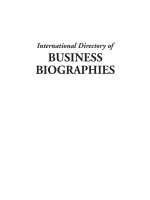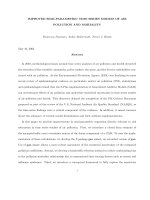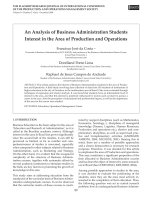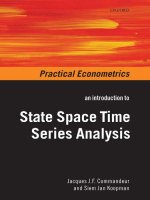Nonlinear time series analysis of business cycles volume 276 (contributions to economic analysis)
Bạn đang xem bản rút gọn của tài liệu. Xem và tải ngay bản đầy đủ của tài liệu tại đây (3.86 MB, 461 trang )
NONLINEAR TIME SERIES ANALYSIS
OF BUSINESS CYCLES
i
CONTRIBUTIONS
TO
ECONOMIC ANALYSIS
276
Honorary Editors:
D.W. JORGENSON
J. TINBERGENy
Editors:
B. Baltagi
E. Sadka
D. Wildasin
Amsterdam – Boston – Heidelberg – London – New York – Oxford – Paris
San Diego – San Francisco – Singapore – Sydney – Tokyo
ii
NONLINEAR TIME SERIES
ANALYSIS OF BUSINESS CYCLES
Costas Milas
Department of Economics, Keele University, UK
Philip Rothman
Department of Economics, East Carolina University, USA
Dick van Dijk
Econometric Institute, Erasmus University Rotterdam, The Netherlands
Amsterdam – Boston – Heidelberg – London – New York – Oxford – Paris
San Diego – San Francisco – Singapore – Sydney – Tokyo
iii
ELSEVIER B.V.
Radarweg 29
P.O. Box 211
1000 AE Amsterdam
The Netherlands
ELSEVIER Inc.
525 B Street, Suite 1900
San Diego
CA 92101-4495
USA
ELSEVIER Ltd
The Boulevard, Langford
Lane, Kidlington
Oxford OX5 1GB
UK
ELSEVIER Ltd
84 Theobalds Road
London
WC1X 8RR
UK
r 2006 Elsevier B.V. All rights reserved.
This work is protected under copyright by Elsevier B.V., and the following terms and conditions apply to its use:
Photocopying
Single photocopies of single chapters may be made for personal use as allowed by national copyright laws.
Permission of the Publisher and payment of a fee is required for all other photocopying, including multiple or
systematic copying, copying for advertising or promotional purposes, resale, and all forms of document delivery.
Special rates are available for educational institutions that wish to make photocopies for non-profit educational
classroom use.
Permissions may be sought directly from Elsevier’s Rights Department in Oxford, UK: phone (+44) 1865 843830,
fax (+44) 1865 853333, e-mail: Requests may also be completed on-line via the Elsevier
homepage ( />In the USA, users may clear permissions and make payments through the Copyright Clearance Center, Inc., 222
Rosewood Drive, Danvers, MA 01923, USA; phone: (+1) (978) 7508400, fax: (+1) (978) 7504744, and in the UK
through the Copyright Licensing Agency Rapid Clearance Service (CLARCS), 90 Tottenham Court Road,
London W1P 0LP, UK; phone: (+44) 20 7631 5555; fax: (+44) 20 7631 5500. Other countries may have a local
reprographic rights agency for payments.
Derivative Works
Tables of contents may be reproduced for internal circulation, but permission of the Publisher is required for
external resale or distribution of such material. Permission of the Publisher is required for all other derivative
works, including compilations and translations.
Electronic Storage or Usage
Permission of the Publisher is required to store or use electronically any material contained in this work, including
any chapter or part of a chapter.
Except as outlined above, no part of this work may be reproduced, stored in a retrieval system or transmitted in
any form or by any means, electronic, mechanical, photocopying, recording or otherwise, without prior written
permission of the Publisher.
Address permissions requests to: Elsevier’s Rights Department, at the fax and e-mail addresses noted above.
Notice
No responsibility is assumed by the Publisher for any injury and/or damage to persons or property as a matter of
products liability, negligence or otherwise, or from any use or operation of any methods, products, instructions or
ideas contained in the material herein. Because of rapid advances in the medical sciences, in particular, independent
verification of diagnoses and drug dosages should be made.
First edition 2006
Library of Congress Cataloging in Publication Data
A catalog record is available from the Library of Congress.
British Library Cataloguing in Publication Data
A catalogue record is available from the British Library.
ISBN-13:
ISBN-10:
ISSN (series):
978-0-444-51838-5
0-444-51838-x
0573-8555
∞ The paper used in this publication meets the requirements of ANSI/NISO Z39.48-1992 (Permanence of Paper).
Printed in The Netherlands.
Working together to grow
libraries in developing countries
www.elsevier.com | www.bookaid.org | www.sabre.org
iv
Dedication
DvD: To my nephews and nieces Judith, Gert-Jan, Suely, Matthijs, Ruben,
Jacco, Nienke and Dani
CM: To my wife, Gabriella and my daughter Francesca
PR: To my mother, Laura Rothman
v
This page intentionally left blank
vi
INTRODUCTION TO THE SERIES
This series consists of a number of hitherto unpublished studies, which are introduced by the editors
in the belief that they represent fresh contributions to economic science.
The term ‘economic analysis’ as used in the title of the series has been adopted because it covers both
the activities of the theoretical economist and the research worker.
Although the analytical methods used by the various contributors are not the same, they are
nevertheless conditioned by the common origin of their studies, namely theoretical problems
encountered in practical research. Since for this reason, business cycle research and national
accounting, research work on behalf of economic policy, and problems of planning are the main
sources of the subjects dealt with, they necessarily determine the manner of approach adopted by the
authors. Their methods tend to be ‘practical’ in the sense of not being too far remote from
application to actual economic conditions. In addition they are quantitative.
It is the hope of the editors that the publication of these studies will help to stimulate the exchange of
scientific information and to reinforce international cooperation in the field of economics.
The Editors
vii
This page intentionally left blank
viii
Introduction
The notion of business cycle nonlinearity goes back a long time. For example,
Mitchell (1927) and Keynes (1936) suggested that business cycles display asymmetric behavior in the sense that recessions are shorter and more volatile than
expansions. Similarly, Hicks (1950) noted that business cycle troughs are sharper
than peaks. Further, Friedman (1964) proposed his ‘‘plucking model’’ of economic fluctuations based upon the observation of asymmetry in correlations
between successive phases of the business cycle, in the sense that the amplitude
of a contraction is strongly correlated with the strength of the subsequent expansion, while the amplitude of an expansion is uncorrelated with the amplitude
of the following contraction.
Neftc- i (1984) initiated the modern econometric literature on business cycle
nonlinearity with his study of U.S. unemployment rates using Markov chain
techniques. His results implied that the U.S. unemployment rate displays
‘‘steepness’’-type business cycle asymmetry, following the taxonomy due to Sichel (1993). Neftc- i’s paper has been highly influential and since its publication
roughly 20 years ago, a great deal of research has been done exploring the
magnitude and economic significance of nonlinearity in business cycle fluctuations. For example, Hamilton (1989, p. 359) argued that the now very popular
Markov-switching model he introduced is a natural generalization of Neftc- i’s
framework. A useful survey of many important developments in this literature
can be found in Clements and Krolzig (2003).
To provide a comprehensive look at current work on this topic, for this book
volume we solicited original contributions on business cycle nonlinearity from
leading academics and practitioners in the field. Each chapter was subsequently
reviewed by an ‘‘internal’’ referee (an author or coauthor of a different chapter
in the book), and by an ‘‘external’’ referee. These external referees were Don
Harding (University of Melbourne), Christopher Martin (Brunel University),
Marcelo Medeiros (PUC Rio), Simon van Nordon (HEC Montre´al), Richard
Paap (Erasmus University Rotterdam), Jean-Yves Pitarakis (University of
Southampton), Tommaso Proietti (University of Udine), Pierre Siklos (Wilfred
Laurier University), Peter Summers (Texas Tech University), Timo Tera¨svirta
(Stockholm School of Economics), Gilles Teyssiere (Universite´ Paris 1), Greg
Tkacz (Bank of Canada), Mark Wohar (University of Nebraska at Omaha), and
Eric Zivot (University of Washington). We thank both our contributors and
ix
x
referees for their cooperation in keeping to the ambitious time schedule we set at
the start of this project.
The papers in this volume can be classified into five groups, each focusing on
a particular topic. The first question considered, in a group of three papers, is the
role of nonlinearity in dating business cycle turning points and identifying business cycle regimes. Chauvet and Hamilton provide a detailed description of the
Markov-switching approach to this issue, including not only the technicalities
involved but also paying ample attention to the underlying intuition. They illustrate the promise of this approach by constructing a business cycle chronology for the U.S. based on real-time data for the post-World War II period, i.e.
data as they were originally released at each historical date. Their findings
demonstrate that the resulting turning point dates closely match those of the
business cycle dating committee of the National Bureau of Economic Research
(NBER), but the model-based turning points typically become available much
sooner than the NBER ones.
Clements and Galva˜o use the context of predicting business cycle regime
probabilities and output growth in the U.S. to consider the specific issue of
combining forecasts versus combining information in modeling. The simple
models whose forecasts they combine each use a single recession indicator, one
of the components that comprise the Conference Board Composite Leading
Indicator (CLI), as the explanatory variable to the model. Combining this information set in modeling is achieved by using a model selection strategy. For
predicting output growth, their findings support pooling the forecasts of the
single-indicator models, whilst the results are more mixed for predicting recessions and recession probabilities.
Morley and Piger consider the ability of linear autoregressive integrated
moving average (ARIMA) and nonlinear Markov-switching models to reproduce business cycle-related features in U.S. real Gross Domestic Product (GDP)
data. They find that both linear and Markov-switching models are able to reproduce business cycle features such as the average growth rate in recessions, the
average length of recessions, and the total number of recessions. However,
Markov-switching models are found to be better than linear models at reproducing the variability of growth rates in different business cycle phases. Furthermore, only Markov-switching specifications with three regimes or with a
built-in ‘‘bounceback’’ effect are able to reproduce high-growth recoveries following recessions and a strong correlation between the severity of a recession
and the strength of the subsequent recovery.
The second topic analyzed, in a set of two papers, is the use of multivariate
nonlinear models in econometric modeling of business cycles. Koop and Potter
introduce a nonlinear extension of the Vector Autoregressive (VAR) model
which they call the Vector Floor and Ceiling (VFC) model. The VFC model is
also a multivariate extension of univariate nonlinear models the authors developed earlier with floor and ceiling effects; see Pesaran and Potter (1997) and
xi
Koop and Potter (2003). As a tightly restricted Threshold Autoregressive model,
the authors argue that the VFC model provides a parsimonious framework for
capturing the type of business cycle nonlinearity suggested by economic theory.
They use both classical and Bayesian methods to analyze the estimated models.
Their results suggest strong nonlinearities in the contemporaneous relationships
between the variables and weaker evidence of conditional mean nonlinearity.
Camacho and Perez-Quiros propose a new framework to analyze pairwise
business cycle synchronization across a given set of countries. The approach is
based on multivariate Markov-switching procedures, and essentially determines
the relative position of two countries’ cycles in between the extreme cases of
complete independence and perfect synchronization. An empirical application to
the G7 countries shows that these can be divided into two groups with distinct
common business cycle dynamics, with one group consisting of Euro-zone
countries (France, Germany, and Italy) and the other including English-speaking countries (Canada, the U.K., and the U.S.).
Five of the papers explore a third topic, the extent to which nonlinearity can
account for the well-documented instability and structural change which has
been observed in macroeconomic time series; see, e.g. Stock and Watson (1996).
Marcellino’s paper is motivated by the many economic and political changes
which have occurred in what is now called the Euro-zone since the early 1980s.
Such changes, he argues, increase the difficulty of modeling macroeconomic time
series for Euro-area countries with constant-parameter linear models. To explore this idea he carries out a simulated out-of-sample forecasting competition
using linear, nonlinear, and time-varying models to predict the future values of
500 macroeconomic time series for these countries. It turns out that, for roughly
two-thirds of the series studied, nonlinear and time-varying models work best.
These results lead him to conclude that use of such models should be strongly
considered by practitioners.
Kapetanios and Tzavalis use a new model of structural breaks, one which
allows for parameter changes to be triggered by large economic shocks. In
contrast to other structural break models in the literature, their approach allows
them to examine such parameter changes without fixing either the number or
magnitude of the breaks. The results support the view that the observed instability in U.S. macroeconomic time series is due to the oil-price shocks of the
1970s and the changes in the Fed’s operating procedures in the late 1970s and
early 1980s.
There are many nonparametric and model-based methods available for extracting the business cycle component from a macroeconomic time series. Koopman, Lee, and Wong use a parametric trend-cycle decomposition procedure
in which the parameters governing the dynamics of these components are allowed to vary in a nonlinear but smooth manner. They find substantial evidence
of smooth time variation in these parameters. Of particular interest are
their results suggesting that business cycle volatility for the U.S. economy has
xii
decreased. While these findings are consistent with results reported earlier in the
literature on the ‘‘great moderation,’’ it is the first to do so within the trend-cycle
decomposition framework.
Becker, Enders, and Hurn develop a methodology to model a time-varying
intercept. The methodology relies on a Fourier approximation, which uses trigonometric functions to capture the unknown functional form of the intercept
term. Two empirical applications illustrate the use of the methodology. The first
example demonstrates how a time-varying intercept can be used to capture a
structural break in the U.S. inflation rate. The second example relates to the U.S.
long-run money demand function. The authors show that the apparent instability in the cointegrating vector among M3, income, prices and interest rates
disappears once a time-varying intercept is taken into account.
Anderson and Low extend the family of smooth transition autoregressive
(STAR) models by proposing a specification in which the autoregressive parameters follow random walks. The random walks in the parameters capture
permanent structural change within a regime-switching framework, but in contrast to existing specifications, structural change in the random walk STAR
(RW-STAR) setting follows a stochastic process rather than a deterministic
function of time. Using industrial production data for several countries, they
find evidence of nonconstant parameters in a setting where there is also evidence
of regime-switching. In addition, they find that RW-STAR models seem to be
able to capture different types of time-varying behavior of parameters.
The fourth topic, the importance of nonlinearity for econometric analysis of
monetary policy, is addressed in three of the papers in this volume. Kesriyeli,
Osborn, and Sensier estimate smooth transition monetary policy rules for the
U.S., U.K., and Germany. They find significant nonlinear structure in the
monetary policy rules associated with interest rate changes rather than movements in the inflation rate or the output gap. The nonlinear models also identify
a significant shift in the parameter values of the U.S. and U.K. interest rate
reaction functions occurring around mid-1985.
Dolado and Marı´ a-Dolores examine the issue of the asymmetric effects of
monetary policy shocks on output in the Euro area. Assuming a nonlinear
aggregate supply curve, they derive monetary policy shocks as the residuals from
a nonlinear interest rate reaction function. The authors proceed by estimating a
multivariate Markov-switching model for EU output and find that monetary
policy shocks have a greater effect on output in recessions.
Akram, Eitrheim, and Sarno adopt a different nonlinear model but reach
similar conclusions on the effects of monetary policy on output. The authors use
multivariate smooth transition models to characterize the behavior of output,
money, and the real exchange rate in Norway over a period of almost two
centuries. They find evidence of asymmetric effects of monetary policy on output. In particular, large contractionary monetary policy shocks tend to have
significant effects on output, while small expansionary monetary policy shocks
tend to have negligible effects on output.
xiii
Finally, two of the papers study the statistical and economic impact of allowing for business cycle regime-dependent behavior in models of important
macroeconomic and financial time series. Bhardwaj and Swanson compare the
ability of fractional ARIMA (ARFIMA), non-ARFIMA, and other nonlinear
models to forecast U.S. daily stock returns in recessions versus expansions and
for larger versus smaller samples. The findings of their paper suggest that
ARFIMA models do not predict better or worse than any other model across
the business cycle. On the other hand, the forecasting ability of ARFIMA
models increases with larger samples.
Dahl and Kulaksızog˘lu use a nonlinear autoregressive distributed lag model
to study the relationship between housing completions and housing starts in the
U.S. economy. Their results suggest that builders change the speed of construction depending upon whether the home construction industry is in a recession or
expansion. In particular, the mean lag between housing completions and housing starts is significantly shorter in recessionary than in expansionary periods.
This finding is consistent with what has been called the ‘‘accordion effect’’ in the
literature; see van Alphen and Merkies (1976).
References
Clements, M.P. and H.-M. Krolzig (2003), ‘‘Business cycle asymmetries: characterization and testing based on Markov-switching autoregressions’’, Journal of Business and Economic Statistics, Vol. 21, pp. 196–211.
Friedman, M. (1964). ‘‘Monetary studies of the National Bureau’’, in: The National Bureau Enters its 45th Year, 44th Annual Report, pp. 7–25. Reprinted in
M. Friedman, The Optimum Quantity of Money and Other Essays, Chicago:
Aldine. pp. 261–284.
Hamilton, J.D. (1989), ‘‘A new approach to the economic analysis of nonstationary time series and the business cycle’’, Econometrica, Vol. 57, pp.
357–384.
Hicks, J.R. (1950), A Contribution to the Theory of the Trade Cycle, Oxford:
Clarendon Press.
Keynes, J.M. (1936), The General Theory of Employment, Interest and Money,
London: Macmillan.
Koop, G. and S. Potter (2003), ‘‘Bayesian analysis of endogenous delay threshold models’’, Journal of Business and Economic Statistics, Vol. 21, pp. 93–103.
Mitchell, W.C. (1927), Business Cycles: The Problem and its Setting, New York:
NBER.
Neftc- i, S.N. (1984), ‘‘Are economic time series asymmetric over the business
cycle’’, Journal of Political Economy, Vol. 92, pp. 307–328.
Pesaran, M.H. and S. Potter (1997), ‘‘A floor and ceiling model of US output’’,
Journal of Economic Dynamics and Control, Vol. 21, pp. 661–695.
Sichel, D.E. (1993), ‘‘Business cycle asymmetry: a deeper look’’, Economic Inquiry, Vol. 31, pp. 224–236.
xiv
Stock, J.H. and M.W. Watson (1996), ‘‘Evidence on structural instability in
macroeconomic time series relations’’, Journal of Business and Economic
Statistics, Vol. 14, pp. 11–30.
van Alphen, H.J. and A.H.Q.M. Merkies (1976), ‘‘Distributed lags in construction: an empirical study’’, International Economic Review, Vol. 17, pp.
411–430.
CONTENTS
INTRODUCTION
ix
LIST OF CONTRIBUTORS
CHAPTER 1
1.
2.
3.
4.
5.
6.
3.
4.
DATING BUSINESS CYCLE TURNING POINTS
Marcelle Chauvet and James D. Hamilton
Introduction
What can we infer from U.S. GDP growth rates?
Parametric representation
Using multiple indicators to identify turning points
Empirical performance of the monthly recession probability index
Alternative approaches to monthly inference
Acknowledgements
References
Appendix
CHAPTER 2
1.
2.
xxiii
COMBINING PREDICTORS & COMBINING
INFORMATION IN MODELLING: FORECASTING
US RECESSION PROBABILITIES AND OUTPUT
GROWTH
Michael P. Clements and Ana Beatriz Galva˜o
Introduction
Models and data
2.1.
Logit models
2.2.
Models of output growth
2.3.
Non-linear models of output growth
Out-of-sample forecasting exercise
3.1.
Forecast combination schemes
3.2.
Forecast evaluation
3.3.
Empirical results
Conclusions
Acknowledgements
References
xv
1
2
3
10
22
32
48
50
51
53
55
55
58
58
61
62
63
63
63
64
69
70
70
xvi
CHAPTER 3
1.
2.
3.
4.
5.
Introduction
An algorithm for establishing business cycle turning points
Business cycle features in U.S. real GDP data
Business cycle features in simulated data from time-series
models
4.1.
Model description and estimation
4.2.
Business cycle features from linear models
4.3.
Business cycle features from regime-switching
models
4.4.
Business cycle features and heteroskedasticity
Conclusions
Acknowledgements
References
CHAPTER 4
1.
2.
3.
4.
5.
THE VECTOR FLOOR AND CEILING MODEL
Gary Koop and Simon Potter
Introduction
A nonlinear VAR with floor and ceiling effects
Empirical results
3.1.
Model comparison results
3.2.
A comparison of Bayesian and classical results
Impulse response analysis
Conclusions
Acknowledgements
References
Appendix A: Sample information
Appendix B: Bayesian analysis of the VFC model
Appendix C: Classical analysis of the VFC model
Appendix D: Further details on impulse response analysis
CHAPTER 5
1.
2.
THE IMPORTANCE OF NONLINEARITY IN
REPRODUCING BUSINESS CYCLE FEATURES
James Morley and Jeremy Piger
A NEW FRAMEWORK TO ANALYZE BUSINESS
CYCLE SYNCHRONIZATION
Maximo Camacho and Gabriel Perez-Quiros
Introduction
A framework to analyze business cycle synchronization
2.1.
Univariate Markov-switching approach
2.2.
Multivariate Markov-switching approach
75
75
79
81
83
83
87
88
90
92
93
93
97
97
99
105
106
109
113
118
118
119
121
122
128
131
133
133
135
135
136
xvii
3.
4.
Empirical results
3.1.
Preliminary analysis of data
3.2.
Comparative analysis of business cycle synchronization
3.3.
Business cycle synchronization across G7 countries
Conclusions
Acknowledgements
References
CHAPTER 6
1.
2.
3.
4.
5.
6.
7.
Introduction
The data
Forecasting methods
3.1.
Linear methods
3.2.
Time-varying methods
3.3.
Non-linear methods
Forecast evaluation
Measuring the extent of instability
5.1.
Instability tests
5.2.
Forecast evaluation for unstable series
Forecasting industrial production, unemployment
and inflation
Conclusions
Acknowledgements
References
CHAPTER 7
1.
2.
3.
4.
5.
NON-LINEARITY AND INSTABILITY IN THE
EURO AREA
Massimiliano Marcellino
NONLINEAR MODELLING OF
AUTOREGRESSIVE STRUCTURAL
BREAKS IN SOME US
MACROECONOMIC SERIES
George Kapetanios and Elias Tzavalis
Introduction
Modelling structural breaks in autoregressive coefficients
A Monte Carlo study
Empirical application
Conclusions
Acknowledgements
References
Data Appendix
139
139
143
145
148
148
148
151
151
153
154
155
156
156
158
163
163
165
168
171
172
172
175
175
177
183
184
195
195
195
197
xviii
CHAPTER 8
1.
2.
3.
4.
5.
Introduction
Trend-cycle decomposition model
2.1.
Fixed parameter specification
2.2.
Time-varying parameter specification
State space representation
Empirical evidence from U.S. economic time series
4.1.
Data
4.2.
Basic decompositions
4.3.
Smooth transitions over time
Discussion and conclusion
References
Appendix
CHAPTER 9
1.
2.
3.
4.
5.
6.
TREND-CYCLE DECOMPOSITION MODELS
WITH SMOOTH-TRANSITION PARAMETERS:
EVIDENCE FROM U.S. ECONOMIC TIME
SERIES
Siem Jan Koopman, Kai Ming Lee and
Soon Yip Wong
MODELING INFLATION AND MONEY
DEMAND USING A FOURIER-SERIES
APPROXIMATION
Ralf Becker, Walter Enders and Stan Hurn
Introduction
Modeling with a Fourier approximation
2.1.
Dependent error structures
2.2.
Power
A structural break in the inflation rate
Selecting the optimal number of terms in the
Fourier expansion
Structural breaks in the demand for money
5.1.
The bootstrap
5.2.
The error-correction model
5.3.
The restricted model
5.4.
Integer frequencies
5.5.
Missing variables
Conclusions
Acknowledgements
References
199
199
202
202
203
205
206
206
206
209
216
217
218
221
222
224
228
228
230
233
234
238
240
240
241
242
243
244
244
xix
CHAPTER 10
1.
2.
3.
4.
5.
Introduction
The RW-STAR Model
2.1.
The model
Modelling procedure
3.1.
Performance of the nonlinearity tests
Modelling industrial production of selected OECD
countries
4.1.
The data
4.2.
Linearity tests
4.3.
Development of baseline models
4.4.
Estimation of RW-STAR models
4.5.
Forecast performance
Conclusions
Acknowledgements
References
Appendix : DGPs for the power simulations
CHAPTER 11
1.
2.
3.
4.
RANDOM WALK SMOOTH TRANSITION
AUTOREGRESSIVE MODELS
Heather M. Anderson and Chin Nam Low
NONLINEARITY AND STRUCTURAL CHANGE IN
INTEREST RATE REACTION FUNCTIONS FOR
THE US, UK AND GERMANY
Mehtap Kesriyeli, Denise R. Osborn and
Marianne Sensier
Introduction
Interest rate models
2.1.
The models
2.2.
Selection of explanatory and transition
variables
2.3.
Sample periods and data
Results
3.1.
Linear models
3.2.
Nonlinear models
Concluding remarks
Acknowledgements
References
Appendix : Modelling methodology and additional
results
247
247
249
249
251
253
255
255
257
258
261
270
277
278
278
280
283
283
285
285
288
289
292
292
295
302
303
303
305
xx
CHAPTER 12
1.
2.
3.
4.
5.
6.
Introduction
Related literature
Estimation of a monetary policy reaction function
Markov Switching Models for real output growth
4.1.
Extended Markov Switching model including
interest-rate shocks
Effects of monetary policy on state switches
Conclusions
Acknowledgements
References
CHAPTER 13
1.
2.
3.
4.
5.
6.
STATE ASYMMETRIES IN THE EFFECTS OF
MONETARY POLICY SHOCKS ON OUTPUT:
SOME NEW EVIDENCE FOR THE EURO-AREA
Juan J. Dolado and Ramo´n Marı´a-Dolores
NON-LINEAR DYNAMICS IN OUTPUT, REAL
EXCHANGE RATES AND REAL MONEY
BALANCES: NORWAY, 1830–2003
Q. Farooq Akram, Øyvind Eitrheim and Lucio Sarno
Introduction
STR models
2.1.
Testing for non-linearity and its form
2.2.
Evaluation of STR models
Data and its properties
Multivariate linear models
4.1.
Linear dynamic models
Non-linear conditional models
5.1.
STR models of output, the real exchange rate and
real money
5.2.
The STR models
5.3.
LSTR model of output
5.4.
STR model of the real exchange rate
5.5.
LSTR model of real money
5.6.
Dynamics of the linear versus the non-linear systems of
equations
Concluding remarks
Acknowledgements
References
Appendix : Data
311
311
313
315
320
321
326
328
329
329
333
333
336
337
338
339
347
350
354
355
358
359
362
366
369
371
372
372
376
xxi
CHAPTER 14
1.
2.
3.
4.
5.
6.
Introduction
Empirical methods
2.1.
Long memory model estimation
2.2.
Short memory models
2.3.
Nonlinear STAR models
Predictive accuracy testing
Predictive model selection
Empirical results
5.1.
S&P500 returns: business cycle effects
Concluding remarks
Acknowledgements
References
CHAPTER 15
1.
2.
3.
4.
5.
6.
A PREDICTIVE COMPARISON OF SOME SIMPLE
LONG- AND SHORT MEMORY MODELS OF
DAILY U.S. STOCK RETURNS, WITH EMPHASIS
ON BUSINESS CYCLE EFFECTS
Geetesh Bhardwaj and Norman R. Swanson
NONLINEAR MODELING OF THE CHANGING
LAG STRUCTURE IN U.S. HOUSING
CONSTRUCTION
Christian M. Dahl and Tamer Kulaksizog˘lu
Introduction
The data
Unrestricted finite distributed lag model
The autoregressive distributed lag model
Nonlinear autoregressive distributed lag models
Conclusions
Acknowledgements
References
SUBJECT INDEX
379
379
381
382
386
387
387
390
391
395
400
400
400
407
407
409
412
416
419
427
428
428
431
This page intentionally left blank
xxii
List of Contributors
Q. Farooq Akram
Norges Bank, Norway
Heather Anderson
School of Economics, Australian National
University, Australia
Ralf Becker
Center for Growth and Business Cycle Research,
University of Manchester, UK
Geetesh Bhardwaj
Department of Economics, Rutgers University,
USA
Maximo Camacho
Departamento de Metodos Cuantitativos,
Universidad de Murcia, Spain
Marcelle Chauvet
Department of Economics, University of
California Riverside, USA
Michael P. Clements
Department of Economics, University of
Warwick, UK
Christian M. Dahl
Department of Economics, Purdue University,
USA
Juan Jose´ Dolado
Department of Economics, Universidad Carlos
III de Madrid, Spain
Øyvind Eitrheim
Norges Bank, Norway
Walter Enders
Department of Economics and Finance,
University of Alabama, USA
Ana Beatriz Galva˜o
Ibmec Sa˜o Paulo, Brazil
James D. Hamilton
Department of Economics, University of
California San Diego, USA
Stan Hurn
School of Economics and Finance, Queensland
University of Technology, Australia
George Kapetanios
Department of Economics, Queen Mary,
University of London, UK
Mehtap Kesriyeli
Central Bank of Turkey, Turkey
xxiii
xxiv
Gary Koop
Department of Economics, University of
Strathclyde, UK
Siem Jan Koopman
Department of Econometrics, Vrije Universiteit
Amsterdam, The Netherlands
Tamer Kulaksızog˘lu
Department of Economics, Purdue University,
USA
Kai Ming Lee
Department of Econometrics, Vrije Universiteit
Amsterdam, The Netherlands
Chin Nam Low
Department of Econometrics and Business
Statistics, Monash University, Australia
Ramo´n Marı´a-Dolores
Universidad de Murcia, Departament of
Economic Analysis, Spain
Massimiliano Marcellino
IGIER-Universita` Bocconi, Italy
James Morley
Department of Economics, Washington
University at St. Louis, USA
Denise R. Osborn
Centre for Growth and Business Cycle Research,
Economics, School of Social Sciences, University
of Manchester, UK
Gabriel Perez-Quiros
Dpto Politica Economica del Pte. del Gobierno,
Madrid, Spain
Jeremy Piger
Federal Reserve Bank of Saint Louis, USA
Simon Potter
Federal Reserve Bank of New York, USA
Lucio Sarno
Warwick Business School, University of Warwick,
UK
Marianne Sensier
Centre for Growth and Business Cycle Research,
Economics, School of Social Sciences, University
of Manchester, UK
Norman R. Swanson
Department of Economics, Rutgers University,
USA
Elias Tzavalis
Department of Economics, Queen Mary,
University of London, UK
Soon Yip Wong
Department of Econometrics, Vrije Universiteit
Amsterdam, The Netherlands









